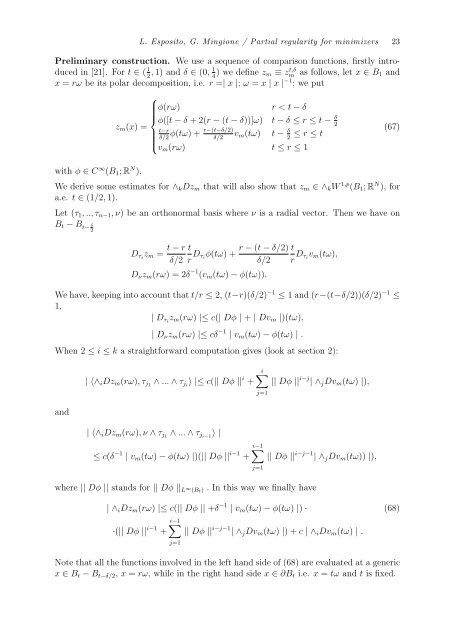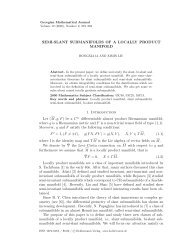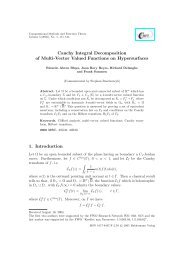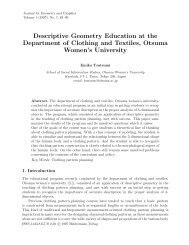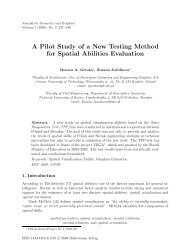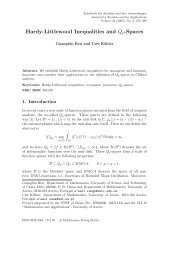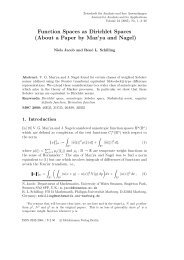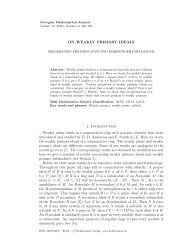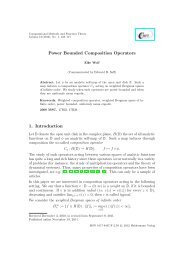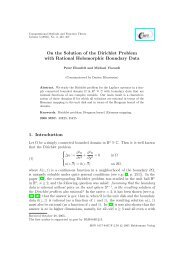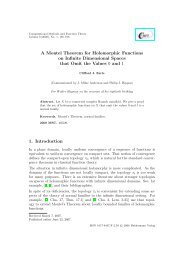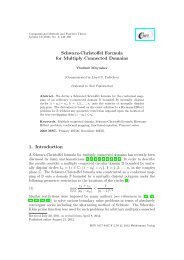Partial Regularity for Minimizers of Degenerate Polyconvex Energies
Partial Regularity for Minimizers of Degenerate Polyconvex Energies
Partial Regularity for Minimizers of Degenerate Polyconvex Energies
You also want an ePaper? Increase the reach of your titles
YUMPU automatically turns print PDFs into web optimized ePapers that Google loves.
L. Esposito, G. Mingione / <strong>Partial</strong> regularity <strong>for</strong> minimizers 23<br />
Preliminary construction. We use a sequence <strong>of</strong> comparison functions, firstly introduced<br />
in [21]. For t ∈ ( 1, 1) and δ ∈ (0, 1) we define z 2 4 m ≡ zm<br />
t,δ as follows, let x ∈ B 1 and<br />
x = rω be its polar decomposition, i.e. r =| x |; ω = x | x | −1 ; we put<br />
with φ ∈ C ∞ (B 1 ; R N ).<br />
⎧<br />
φ(rω)<br />
r < t − δ<br />
⎪⎨<br />
φ([t − δ + 2(r − (t − δ))]ω) t − δ ≤ r ≤ t − δ 2<br />
z m (x) =<br />
t−r<br />
r−(t−δ/2)<br />
φ(tω) + v<br />
δ/2 δ/2 m (tω) t − δ 2<br />
⎪⎩<br />
≤ r ≤ t<br />
v m (rω) t ≤ r ≤ 1<br />
We derive some estimates <strong>for</strong> ∧ k Dz m that will also show that z m ∈ ∧ k W 1,p (B 1 ; R N ), <strong>for</strong><br />
a.e. t ∈ (1/2, 1).<br />
Let (τ 1 , .., τ n−1 , ν) be an orthonormal basis where ν is a radial vector. Then we have on<br />
B t − B t−<br />
δ<br />
2<br />
D τi z m = t − r<br />
δ/2<br />
t<br />
r D τ i<br />
φ(tω) +<br />
r − (t − δ/2)<br />
δ/2<br />
D ν z m (rω) = 2δ −1 (v m (tω) − φ(tω)).<br />
t<br />
r D τ i<br />
v m (tω),<br />
We have, keeping into account that t/r ≤ 2, (t−r)(δ/2) −1 ≤ 1 and (r−(t−δ/2))(δ/2) −1 ≤<br />
1,<br />
| D τi z m (rω) |≤ c(| Dφ | + | Dv m |)(tω),<br />
| D ν z m (rω) |≤ cδ −1 | v m (tω) − φ(tω) | .<br />
When 2 ≤ i ≤ k a straight<strong>for</strong>ward computation gives (look at section 2):<br />
and<br />
| 〈∧ i Dz m (rω), τ j1 ∧ ... ∧ τ ji 〉 |≤ c(|| Dφ || i +<br />
| 〈∧ i Dz m (rω), ν ∧ τ j1 ∧ ... ∧ τ ji−1 〉 |<br />
i∑<br />
|| Dφ || i−j | ∧ j Dv m (tω) |),<br />
∑i−1<br />
≤ c(δ −1 | v m (tω) − φ(tω) |)(|| Dφ || i−1 + || Dφ || i−j−1 | ∧ j Dv m (tω)) |),<br />
where || Dφ || stands <strong>for</strong> || Dφ || L ∞ (B t ) . In this way we finally have<br />
j=1<br />
j=1<br />
(67)<br />
| ∧ i Dz m (rω) |≤ c(|| Dφ || +δ −1 | v m (tω) − φ(tω) |) · (68)<br />
∑i−1<br />
·(|| Dφ || i−1 + || Dφ || i−j−1 | ∧ j Dv m (tω) |) + c | ∧ i Dv m (tω) | .<br />
j=1<br />
Note that all the functions involved in the left hand side <strong>of</strong> (68) are evaluated at a generic<br />
x ∈ B t − B t−δ/2 , x = rω, while in the right hand side x ∈ ∂B t i.e. x = tω and t is fixed.


